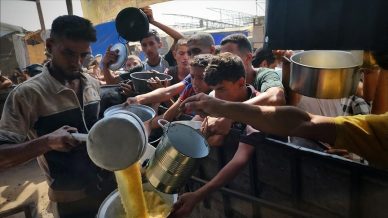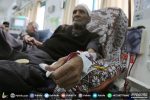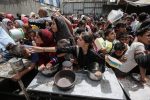GAZA, (PIC)
The hopes of Rawya Hillis to improve her health condition and get rid of the wheelchair that has been her companion for 5 years have dwindled. Before the outbreak of the Israeli war on Gaza, Rawya (43 years old) was committed to physical therapy sessions 3 times a week and could feel her leg to some extent.
However, since the start of the Israeli extermination war on the Gaza Strip on the seventh of October 2023, and her forced displacement from her home, the mother of five children has not undergone any physical therapy sessions, which has led to the stiffening of her leg as she no longer feels it at all.
She says, “I used to use special treatment to stimulate the nerves of my right foot. But the condition of my foot has deteriorated to the worst, and it has become 99% inactive, sluggish, and weak in movement.”
The suffering of displacement
According to her testimony published by the Palestinian Center for Human Rights, Rawya was displaced from her home located on the eastern outskirts of the Gaza Strip, across from the Israeli Nahal Oz site, along with thousands of residents of the Shujaiya neighborhood. It was not easy for her, as she lives on the second floor, where one of her sons lowered the wheelchair and another helped her down the stairs, while her daughter carried her immovable foot down the stairs until they reached the street.
She says, “I went out and my sons were running and dragging my special wheelchair. We stayed for three days in my family’s house in the western area of Shujaiya, and on the tenth of October we were displaced from my family’s house due to the intense bombing at night to the Tel Al-Hawa area in the Tel Al-Hawa Girls School.”
The school was very crowded with displaced people and there was no space, so the family took the corridors as a refuge. “We were 35 people in a very narrow place where we stayed for 3 days before we were forced to be displaced again to central Gaza Strip after we received (Israeli) messages ordering the displaced (in the school) to evacuate towards the south,” she elaborated.
She adds, “We found a driver to take us south, but he refused to transport my wheelchair and agreed to only take the women, so my sons and brothers had to put some blankets on the wheelchair and drag it all the way from Gaza to Deir Al-Balah. We arrived approximately in the Deir Al-Balah area at the time of the Maghrib (sunset) prayer. The road was very crowded, and thousands of residents from Gaza and its north were being displaced on that day.”
Rawya explains that she has been using a wheelchair since 2018, two years after her husband’s death, “I developed spinal cord clots due to the severe grief over my husband, who was previously injured by the occupation and later martyred due to his injury. From that time on, I have been confined to a wheelchair.”
Her sons and brothers could not find an empty space on the ground floor near the sanitary facilities suitable for her health condition, so one of the families and her daughter welcomed her in one of the ground floor classrooms.
Rawya continues, “Now I need a wheelchair, my feet are on the ground because the wheels of the chair I had are damaged, and I cannot use it alone, in addition to my need for a medical bed. The bed available to me currently is just some wooden boards that my sons have assembled into a bed.”
Rawya expressed her pain over the interruption of her physiotherapy, as there were real opportunities to regain her ability to walk. “Today, I can no longer move my feet, and my hopes of walking again and feeling my feet have diminished. My condition has regressed to the worst, and I am in a state of inactivity, laziness, and 99% reduced mobility.”
Challenges faced by people with disabilities
Individuals with disabilities in Gaza face significant challenges due to the destruction caused by the Israeli bombardment of the Strip, which has led to unhealthy conditions, a lack of healthcare, and the inability of people with disabilities to access the available health services.
According to data released by the Rehabilitation Sector for Persons with Disabilities in the Palestinian NGO Network on Saturday, the war has left around 10,000 people with disabilities in the Gaza Strip.
According to the network, the lives of people with disabilities are at risk due to the severe shortage of water, food, energy, medicines, and medical and rehabilitation services. Many people with disabilities face significant difficulties in overcrowded shelters that are not adapted, which lack the elements of inclusion, further complicating their access to humanitarian aid and the use of bathrooms and other necessary needs and requirements.














